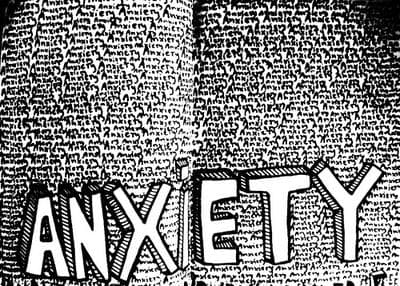Advertisement
Can A Computer Program Help Your Angst?

I asked him later how he managed to contain his anxiety, when mine had run amok. He said he takes a rational approach: he focuses on finding solutions to the things he can control, and tries not to get caught up in the things he can't.
Which is why it makes perfect sense to me that a small study out of Brown University found that anxiety-plagued people who underwent "computerized anxiety therapy" — they were set up on computers with a program to help divert their attention from worrying and instead focus calmly on completing a specific task — grew less anxious. This so-called "cognitive bias modification" worked about as effectively as in-person talk therapy or drugs, researchers report.
Here's the full press release from Brown:
A small clinical trial suggests that cognitive bias modification (CBM), a potential anxiety therapy that is delivered entirely on a computer, may be about as effective as in-person therapy or drugs for treating social anxiety disorder. The Brown University-led research also found that participants believed the therapy to be credible and acceptable.
Participants in the pilot study, published in advance online in the journal Depression and Anxiety, improved their scores on a standardized measure of anxiety and on a public speaking task after completing two simple exercises twice a week for four weeks.
The hope for CBM is that it can provide a new option for anxiety sufferers who cannot find or pay for a qualified therapist, who are afraid to try cognitive behavior therapies where they directly confront their fears, or who can’t or don’t want to try medications. Still, the idea of computer-based therapy has been controversial, acknowledged Courtney Beard, the new study’s lead author and assistant professor (research) of psychiatry and human behavior in the Warren Alpert Medical School of Brown University.
“A lot of people are skeptical, particularly people like me who are clinicians and know how hard it is to help people with anxiety and how much effort and time it takes in therapy,” Beard said. “It just doesn’t seem possible that a computer program could produce similar effects. But I’m more of a scientist than a clinician so I want to see data.”
Beard’s study is the first randomized clinical trial, albeit with a small sample size of 20 people who received the therapy and 12 placebo controls, to combine two techniques of CBM to treat social anxiety disorder: one that seeks to enhance subjects’ control over what they pay attention to and another that trains them to interpret situations less anxiously.
Beard worked on the study with co-authors Risa Weisberg at Brown and Nader Amir at the University of California–San Diego.
Therapy at the computer
The “attention” technique trains subjects to ignore a worrying social cue and instead to complete a task. Subjects were quickly shown both a disgusted face and a neutral face on a split screen. One face would quickly be replaced with a letter, either an E or an F. The subjects’ task was to report which letter they saw. For those receiving the therapy, the neutral face was always the one replaced, meaning the subjects had to divert their attention from the worrisome disgusted face. For the placebo group, either face had an equal chance of being replaced.
The interpretation technique encourages anxiety sufferers to assign benign interpretations to social situations. Subjects were asked to say whether a word they saw on the screen was related to the sentence that followed. Those receiving the therapy, for instance, would see either “embarrassing” or “funny” before seeing the sentence “People laugh after something you said.” The subjects would be told they were correct if they chose the relatively benign word or incorrect if they chose the anxious interpretation. Placebo subjects, meanwhile, saw words that had nothing to do with the situation’s social nature.
The subjects self-reported their anxiety level five times during the four-week period by answering standard questions on the Liebowitz Social Anxiety Scale. The average score of those receiving the therapy dropped from more than 80 to about 60 (lower is better), while those in the placebo group barely edged down at all. Blinded, trained evaluators judged the public speaking task, a five-minute impromptu speech, at the beginning and the end of the study. The scores showed a significant improvement in those who received the therapy, while the speaking scores of the placebo group got worse.
Studies of CBM began in healthy subjects in 2002, but clinical trials of CBM as a therapy for people with anxiety only began to appear in the literature in 2009, Beard said. Hers is the first clinical trial to add a behavioral performance measure, such as public speaking, and is the first to assess whether patients found the treatment credible (e.g., did the therapy make sense?) and acceptable (was this something you could do?). On both issues, participants provided moderately positive assessments.
Not yet proven
Although the study’s results agree with many of the other small studies published to date, Beard said CBM still must be subjected to larger trials with longer follow-up times before the therapy’s seeming effectiveness can be considered convincing.
Even then, she said, it’s unlikely that CBM would displace other forms of treatment for anxiety disorders. Instead, it might prove worthwhile as a first step to try.
“This certainly isn’t going to replace therapy,” she said. “I see it more as a very inexpensive, very easy to deliver, first-line intervention that could help a lot of people. For those it doesn’t help, then maybe we could devote the more expensive and time-intensive resources to them.”
Funding for the study came from the National Institute of Mental Health. Amir has applied for a patent on CBM technology and is part owner of a company that makes CBM software.
This program aired on September 15, 2011. The audio for this program is not available.
